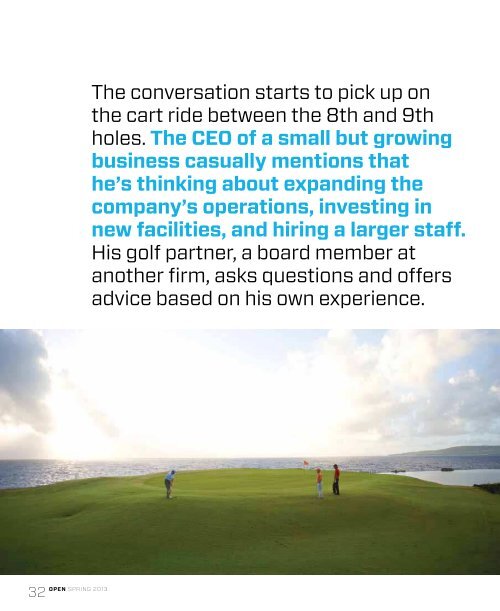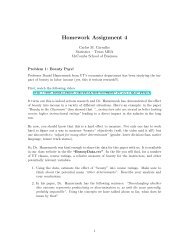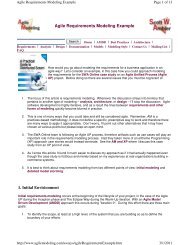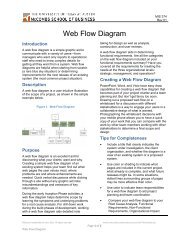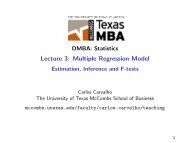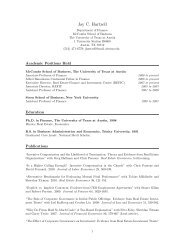Download a PDF version - McCombs TODAY - The University of ...
Download a PDF version - McCombs TODAY - The University of ...
Download a PDF version - McCombs TODAY - The University of ...
Create successful ePaper yourself
Turn your PDF publications into a flip-book with our unique Google optimized e-Paper software.
<strong>The</strong> conversation starts to pick up on<br />
the cart ride between the 8th and 9th<br />
holes. <strong>The</strong> CEO <strong>of</strong> a small but growing<br />
business casually mentions that<br />
he’s thinking about expanding the<br />
company’s operations, investing in<br />
new facilities, and hiring a larger staff.<br />
His golf partner, a board member at<br />
another firm, asks questions and <strong>of</strong>fers<br />
advice based on his own experience.<br />
A productive discussion ensues and, by the end <strong>of</strong> the back<br />
nine, the two part ways feeling more informed about their anticipated<br />
investments.<br />
This common scenario represents more than just a chance networking<br />
opportunity. It could also yield measurable benefits for<br />
each company’s economic performance.<br />
Executives’ influence on company performance extends well<br />
beyond the corporate boardroom. When they’re not at the <strong>of</strong>fice,<br />
they serve on boards at nonpr<strong>of</strong>it organizations and social clubs.<br />
<strong>The</strong>y play golf with former colleagues and get drinks with old<br />
classmates. Often these associates are other executives who are<br />
knowledgeable about the current business climate; when the<br />
small talk winds down, the shop talk begins.<br />
Just as someone would recommend a restaurant or movie to his<br />
or her group <strong>of</strong> friends, executives who share social circles tend to<br />
give each other advice: whether it’s a good time to make corporate<br />
investments, open a new plant, or hire employees. In most cases<br />
there is nothing underhanded about these conversations, provided<br />
no inside financial information is being exchanged.<br />
Cesare Fracassi, an assistant pr<strong>of</strong>essor at <strong>McCombs</strong> who studies<br />
executives’ social networks, says these interactions can equip<br />
corporate leaders to make more educated decisions and improve<br />
their companies’ financial performance.<br />
“Social networks help to create more informed decisions,” Fracassi<br />
says. “When I have more friends, I can decide what restaurant<br />
I want to eat at, what movie I want to watch, and how to invest.”<br />
Go with the Flow<br />
In a recent study, Fracassi traced the social ties between 30,860<br />
executives at 2,059 companies over the course <strong>of</strong> nine years,<br />
identifying connections between those who overlapped at school,<br />
held management positions in the same company, or had memberships<br />
in common social clubs or nonpr<strong>of</strong>it organizations. Next<br />
he looked at company decisions, especially investment patterns.<br />
Fracassi observed that companies led by socially connected<br />
directors increased their investments at similar rates, while companies<br />
with less-connected executives tended to follow more distinct<br />
strategies. This occurs because when one member <strong>of</strong> a social circle<br />
decides to ramp up his or her investments, the CEOs and directors<br />
<strong>of</strong> other firms in the group are inclined to follow suit, Fracassi says.<br />
“<strong>The</strong> more social connections two companies share with each<br />
other, the more similar their investment policies are,” the study<br />
reports. “In addition, two connected companies change their<br />
investment policies over time more similarly than two companies<br />
that are less socially connected.”<br />
This tendency is known as informational cascade. And Fracassi<br />
says it’s <strong>of</strong>ten a good thing.<br />
It Pays to be Social<br />
Being in the loop gives a firm access to a large volume <strong>of</strong> information<br />
to guide financial decisions—but does all that insight<br />
translate into good decisions Fracassi found evidence that when<br />
a group <strong>of</strong> knowledgeable executives starts talking, it pays to be<br />
part <strong>of</strong> the conversation.<br />
“<strong>The</strong>re is evidence that suggests that where the CEO and directors<br />
are more socially involved, the company is more pr<strong>of</strong>itable,”<br />
Fracassi says. “<strong>The</strong> information they receive helps the company<br />
to make the right decisions.”<br />
Specifically, companies that are positioned more centrally<br />
in the web <strong>of</strong> social networks tend to have better economic<br />
results—including greater firm value and a higher return on<br />
assets—than those on the social fringes, the study reports. That<br />
bump could result in a jump in performance <strong>of</strong> 5 to 15 percent.<br />
Because the word-<strong>of</strong>-mouth information passed through social<br />
networks flows freely and at a low cost, it’s advantageous for<br />
companies to collect as much <strong>of</strong> it as possible.<br />
“A strategic position in the network gives a player a competitive<br />
informational advantage relative to other players that are<br />
less connected,” Fracassi writes.<br />
Keep Your Friends Close …<br />
But Not Too Close<br />
While the research indicates that staying connected to outside<br />
social networks can benefit a company’s financial performance,<br />
Fracassi says the opposite may be true for close social relationships<br />
among directors within the same company—specifically<br />
between the CEO and the board <strong>of</strong> directors.<br />
In a 2012 paper, Fracassi and co-author Ge<strong>of</strong>frey Tate <strong>of</strong> the<br />
<strong>University</strong> <strong>of</strong> North Carolina detailed the risks associated with<br />
that type <strong>of</strong> scenario.<br />
At most companies, board members are charged with monitoring<br />
the CEO and holding him or her accountable for poor investment<br />
decisions. But if the CEO and directors are connected through outside<br />
social ties— say, they worked together in the past, went to the<br />
same school, or are members <strong>of</strong> the same nonpr<strong>of</strong>it organization<br />
or club—the monitoring tends to be weaker.<br />
In this scenario, the board tends to be more lenient toward the<br />
CEO, even if he or she starts growing the company too rapidly by<br />
making unwise acquisitions or unproductive investments. This,<br />
in turn, can lead to a dip in the company’s share price, especially<br />
for firms that have weaker shareholder rights.<br />
<strong>The</strong> study also indicates that firms with powerful CEOs are the<br />
most likely to add new directors who have pre-existing connections<br />
to the executive, strengthening those social bonds<br />
Fracassi says this outcome isn’t always the result <strong>of</strong> a conscious<br />
distortion by directors who want to cut a friend some<br />
slack. Rather, it’s that people are naturally more trusting <strong>of</strong><br />
someone they know.<br />
“But this trust leads to CEOs making decisions that harm<br />
shareholders’ value” in the form <strong>of</strong> unwise merger deals, he says.<br />
Some argue that close ties can help improve the exchange<br />
<strong>of</strong> information between executives at the same firm. But overall,<br />
Fracassi’s research suggests that on balance, the negative<br />
effects from these internal social ties <strong>of</strong>ten outweigh the<br />
potential advantages.<br />
“A well-functioning board <strong>of</strong> directors provides both valuable<br />
advice to management and a check on its policies,” the study’s<br />
authors write. “An effective director should not just ‘rubber<br />
stamp’ management’s actions, but should take a contrarian opinion<br />
when management’s proposals are not in the interest <strong>of</strong> the<br />
firm’s shareholders.”<br />
A series <strong>of</strong> legislative measures, including the Sarbanes–Oxley<br />
Act <strong>of</strong> 2002, have taken aim at boardroom corruption, but Fracassi<br />
and Tate have found little evidence that those policies<br />
have significantly discouraged the practice <strong>of</strong> stocking boards<br />
with familiar faces. <strong>The</strong> researchers identify internal networks<br />
<strong>of</strong> CEOs and board members as “an effective target for future<br />
governance reform.” O<br />
Additional reporting by Jeremy Simon<br />
TexasEnterprise.org for more stories featuring business research<br />
@ and analysis from UT faculty.<br />
32 OPEN SPRING 2013 www.today.mccombs.utexas.edu SPRING 2013 OPEN 33<br />
previous spread: Peter Cade, Getty Images ; facing page: flashfilm


